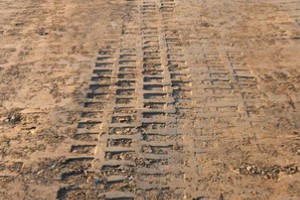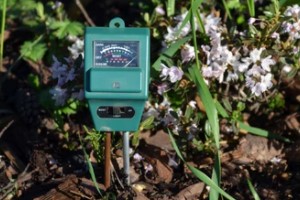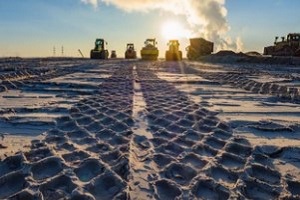 For concrete structures to perform well, it is necessary to build them on firm soil. Soil is made up of solids interspersed with voids of air or water. These voids will compress when soil is loaded by heavy objects. When soil contains fewer voids, the chances are lower that it will experience excessive settlement or sliding, which can compromise the structure that is built on top of it.
For concrete structures to perform well, it is necessary to build them on firm soil. Soil is made up of solids interspersed with voids of air or water. These voids will compress when soil is loaded by heavy objects. When soil contains fewer voids, the chances are lower that it will experience excessive settlement or sliding, which can compromise the structure that is built on top of it.
Achieving proper compaction forces the air out of the voids and reduces their volume, thereby strengthening the soil and minimizing the potential for sliding, settlement, rutting and related problems. This is important because improper compaction can cause structures like floor slabs or concrete foundations to fail years after construction has taken place.
Soil compaction is typically achieved by vibrating the soil mass or applying pressure on the surface of the soil. Different types of soil require a different compaction approach, and the amount of compaction that is needed for a specific type of soil is established using standard testing procedures.
Measuring Compaction
There are measurements that can be used to determine how well a particular type of soil has been compacted. These include the dry unit weight and dry density in pounds per cubic foot. This may be determined by digging holes into the compacted soil and finding the volume of the hole to calculate the dry weight of the soil removed.
It is also possible to measure the dry density of in-place soil using methods such as the rubber balloon method and the nuclear method. Laboratory compaction tests are required to determine how much compaction will be needed for cohesive soils; these soils need the right amount of moisture in order to compact well because their compacted density is so sensitive to the water content at which the compaction takes place.
A Proctor test can be used to determine the amount of compaction that one can reasonably expect to achieve with a given soil. This involves mixing samples of the soil at different water contents in a lab, allowing them to stand for 16 hours or longer, and then compacting them following a standardized procedure to find the maximum dry density and optimum moisture content.
Soil And Moisture
To achieve the right level of compaction, it is necessary to know what type of soil you are working with. Different types of soil have different moisture levels and maximum densities. For example, of the three basic groups of soil – granular, cohesive and organic – only granular (such as sand) and cohesive (such as clay) are suited to compaction.
 However, they are very different; the particles of cohesive soils tend to stick together, while granular soils will crumble easily. This means their absorbency and ease of compaction vary dramatically.
However, they are very different; the particles of cohesive soils tend to stick together, while granular soils will crumble easily. This means their absorbency and ease of compaction vary dramatically.
It is important to keep the soil’s moisture content in mind before beginning compaction work. Soil that has too much moisture will be less stable, while soil that does not have enough moisture will not compact well.
A simple hand test can be used to determine how moist the soil is. This involves picking up a handful of soil, squeezing it, and then opening your hand and allowing the soil to drop to the ground.
Soil that has the ideal moisture level will mold when squeezed together yet break into a few pieces when dropped. Dry soil will be powdery and break up into fragments when dropped, while soil that is too moist to be compacted well will leave your hands wet, and the mold of the soil will stay intact when dropped.
Using The Right Equipment
Another essential component of achieving the right level of soil compaction is using proper equipment. There are several different types of equipment available, and the type of soil in question is the main factor to consider when determining which tools to choose.
For example, rammers and trench rollers are good choices for cohesive soils such as clay-based soils. Granular soils such as sand call for ride-on rollers, walk-behind rollers or reversible plates.
Keep in mind that there are two different types of force that are used to achieve proper levels of soil compaction: static force and vibratory force.
Static Force
This is found in the dead weight of machines. Static force involves applying downward pressure on the surface of the soil to compress soil particles within the top layer of soil.
Vibratory Force
Vibratory force is created using an engine to drive downward force that is applied in conjunction with the machine’s static weight. These vibrations will compress the soil material closer together to raise its density.
Avoiding Compaction Mistakes
 Even experienced contractors can make compaction mistakes if they do not proceed cautiously. It is a job that requires time and careful attention. If an operator makes too many passes in the same direction with the machine, it can cause over-compaction, which lowers the soil density.
Even experienced contractors can make compaction mistakes if they do not proceed cautiously. It is a job that requires time and careful attention. If an operator makes too many passes in the same direction with the machine, it can cause over-compaction, which lowers the soil density.
However, if the operator fails to make enough passes with the machine, it can lead to under-compaction, which means the particles within the soil will be too soft and will not achieve the cohesion needed to get the right level of density.
It is also important to ensure that the soil layer gets the right amount of lift. As soil becomes compacted, the impact is going to travel less and send more energy back to the machine, which can make it come off the ground higher and change the lift; this could result in a loose layer of dirt that is under compacted.
Get In Touch With The Northern Virginia Soil Experts
If you are embarking on any type of project involving soil, get in touch with the Northern Virginia soil experts at Dirt Connections. We are experienced in residential and commercial projects of all sizes and can offer advice on the right type of soil for your project. We can deliver bio mix soils, structural fill dirt and organic topsoil to your site quickly and affordably. Reach out today to learn more about our offerings.
Summary

Dirt Connections was started with one goal in mind: providing quality residential and commercial construction services to clients on time and on budget. Reach out for more information on how we can support your next project.
For your convenience our estimates are free and by appointment. Call 703-940-9949 for a free estimate today!









































